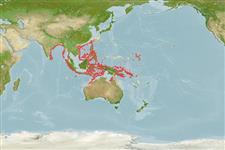>
Scombriformes (Mackerels) >
Scombridae (Mackerels, tunas, bonitos) > Scombrinae
Etymology: Rastrelliger: Latin, rastra = rake + Latin, gero = to carry.
Eponymy: James Lawrence Faughn (1910–1985) worked at the Scripps Institution of Oceanography (1947–1974). [...] (Ref. 128868), visit book page.
Environment: milieu / climate zone / djupintervall / distribution range
Ekologi
marina pelagic-neritic; havsvandrande (Ref. 51243); djupintervall 2 - 150 m (Ref. 128967). Tropical; 26°N - 14°S, 78°E - 157°E (Ref. 168)
Indo-West Pacific: India to Fiji, north to Taiwan.
Size / Vikt / Age
Könsmognad: Lm ? range ? - ? cm
Max length : 24.0 cm FL hane/ej könsbestämd; (Ref. 117079); publicerad maxvikt: 750.00 g (Ref. 168)
Taggstrålar i ryggfenan (totalt) : 8 - 11; Mjukstrålar i ryggfenan (totalt) : 12; Taggstrålar i analfenan: 0; Mjukstrålar i analfenan: 12; Ryggkotor: 31. Head longer than body depth. Maxilla covered by lachrymal bone. Swim bladder present. Interpelvic process small and single. Anal spine rudimentary. Bristles on longest gill raker, 30 to 55 on one side. Gill rakers do not extend far into mouth. A black blotch behind pectoral fin base. The belly is yellowish silver; 2 to 6 large spots are at the base of the first dorsal fin; tow faint stripes are at the level of the lateral line in some specimens.
Body shape (shape guide): fusiform / normal; Cross section: oval.
Epipelagic, neritic species, occurring in waters where surface temperatures do not fall below 17°C. Forms schools of equally sized individuals. Feeds on the largest zooplankton organisms, thus complementing the planktonic food spectrum of the other two Rastrelliger species.
Life cycle and mating behavior
Könsmognad | Reproduktion | Lek | Ägg | Fecundity | Larver
Collette, B.B. and C.E. Nauen, 1983. FAO Species Catalogue. Vol. 2. Scombrids of the world. An annotated and illustrated catalogue of tunas, mackerels, bonitos and related species known to date. Rome: FAO. FAO Fish. Synop. 125(2):137 p. (Ref. 168)
IUCN Red List Status (Ref. 130435: Version 2025-1)
Threat to humans
Harmless
Human uses
Fiskeri: kommersiell; sportfisk: ja
Verktyg
Special reports
Download XML
Internet-källor
Estimates based on models
Preferred temperature (Ref.
123201): 15 - 22.9, mean 18.3 °C (based on 44 cells).
Phylogenetic diversity index (Ref.
82804): PD
50 = 0.6250 [Uniqueness, from 0.5 = low to 2.0 = high].
Bayesian length-weight: a=0.00891 (0.00526 - 0.01511), b=3.04 (2.90 - 3.18), in cm total length, based on LWR estimates for this species & (Sub)family-body (Ref.
93245).
Trofisk nivå (Ref.
69278): 3.4 ±0.45 se; based on food items.
Generation time: 0.8 ( na - na) years. Estimated as median ln(3)/K based on 2
growth studies.
Resiliens (Ref.
120179): Hög, lägsta populationsfördubblingstid mindre än 15 månader (K=1.45).
Fishing Vulnerability (Ref.
59153): Low vulnerability (13 of 100).
🛈
